If you’re looking for the best smartwatch for cycling, you’ve come to the right place. Our team of expert reviewers have put smartwatches from some of the biggest brands to the test.
Why choose a smartwatch for cycling over one of the best bike computers?
The screen size might not be as big as some cycling computers – smartwatches have to be small enough to fit on your wrist – but this makes these wearable devices popular with athletes who partake in multiple sports, triathlons or cross-training.
Many smartwatches now have dedicated cycling modes, will support GPS tracking and connect to other training devices, such as power meters.
Plus, in some cases, smartwatches have more functionality than cycling computers with in-built heart rate monitors and other health tracking metrics, such as calorie counters, step counters and sleep quality monitors.
We have an in-depth guide explaining the advantages and disadvantages of smartwatches over bike computers. But if you already know a smartwatch is for you, we have listed the best smartwatches for cycling.
If you want to find out more about these devices you can skip to our buyer’s guide to smartwatches at the end.
Best smartwatches for cycling in 2024, tried and tested
Garmin Forerunner 945
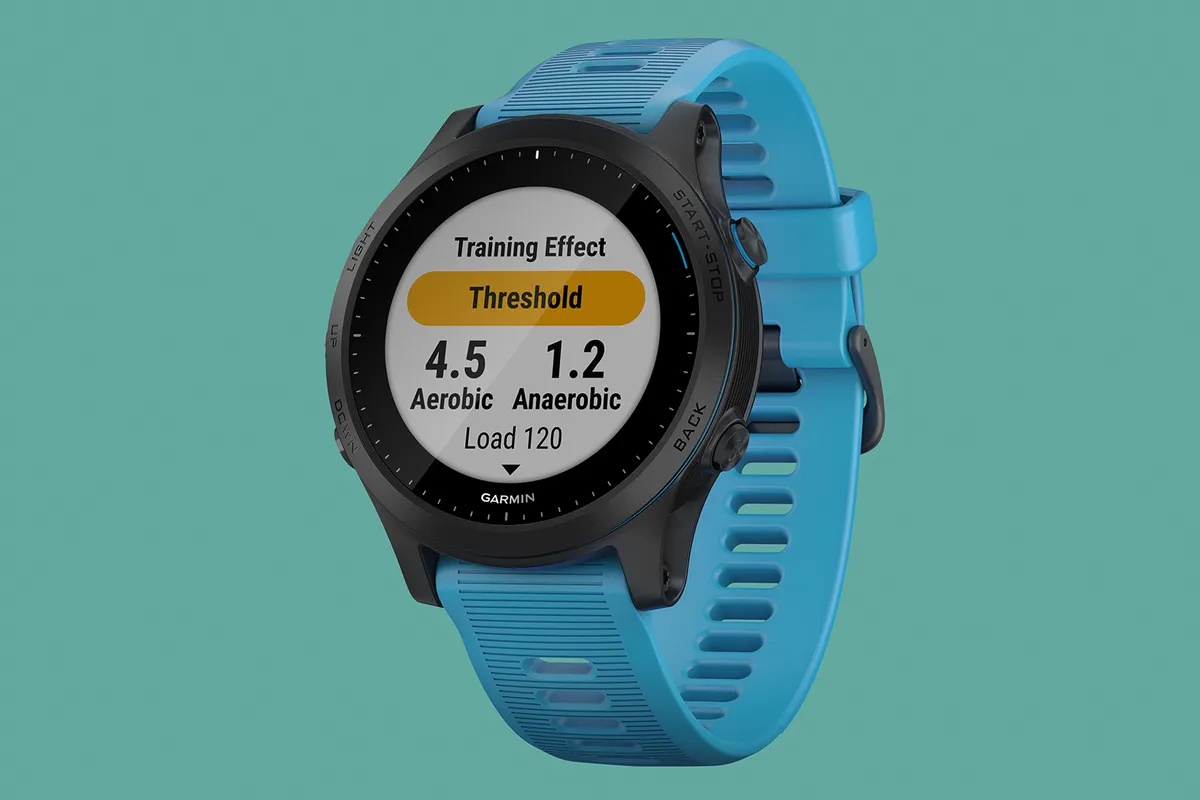
- £500 / €550 / $600 / AU$999 as tested
- Excellent battery life in GPS mode
- Countless features
The Garmin Forerunner 945 improves on its predecessor, the Forerunner 935, by incorporating new features for athletes as well as some more day to day functions that give this Garmin smartwatch extra appeal.
It has a new optical heart-rate sensor and, after a ride, its in-built software will calculate how you benefitted aerobically and anaerobically.
The 30.4mm screen is easy to read and the battery has an impressive 36-hour life in GPS mode.
The watch has ANT , Bluetooth, and WiFi connectivity and will instantly share ride data with most of the best cycling apps on the market.
The Forerunner 945 will also let you play music directly from the watch to Bluetooth headphones and features Garmin Pay for contactless payments.
This is the best Garmin cycling watch we've tested and the only thing holding this watch back is the high price tag.
Amazfit GTR 4
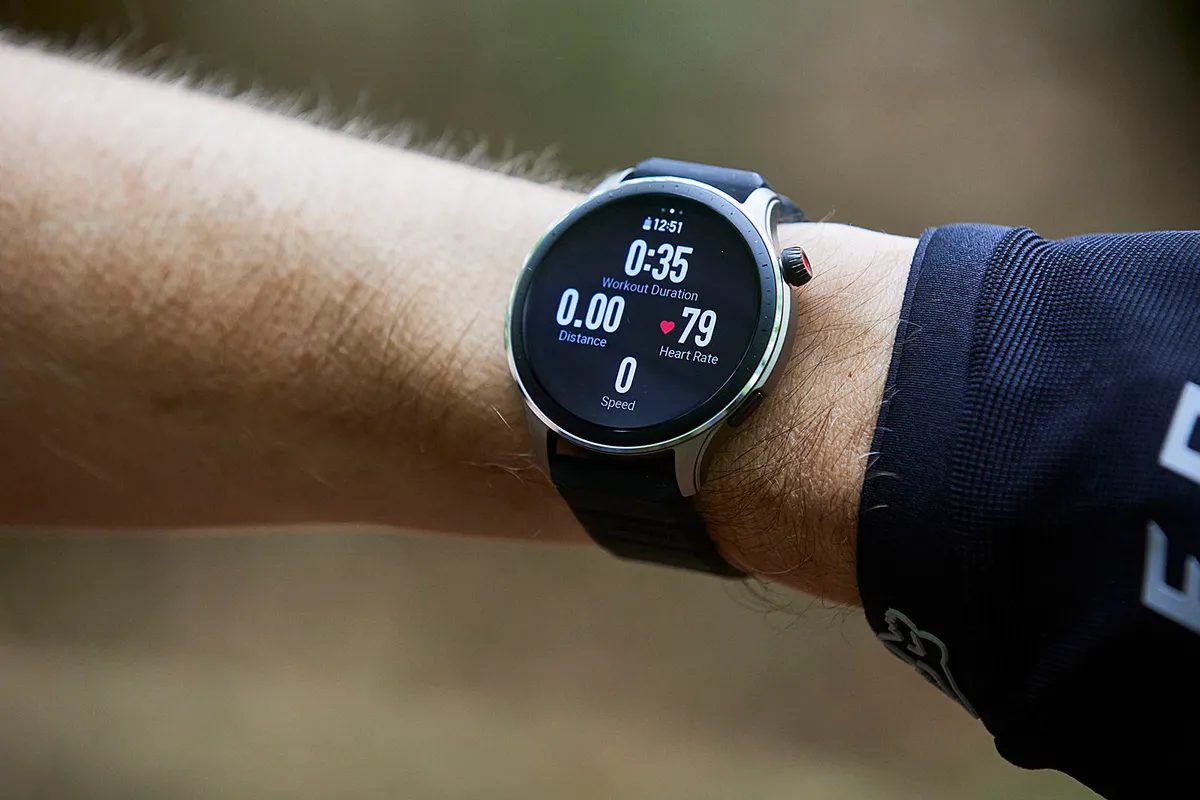
- £199 / €228 / $228 / AU$351 as tested
- Handy cycling features at reasonable cost
- Latent heart rate rate, but no navigation
The Amazfit GTR 4 keeps the best aspects of its forebearer, the GTR 3, but upgrades it to improve usability.
A new optical biometric sensor is claimed to record a third more data than before. Updated software is less glitchy and makes the touchscreen respond quicker.
The smartwatch connects via Bluetooth to your phone to take calls and messages, has an integrated music player and is waterproof.
The Amazfit GTR 4 battery is long-lasting – our tester ran the watch for a week while regularly using Bluetooth and GPS.
Outdoor cycling is among eight standard activity modes and the GPS receiver is quick to find a signal.
The heart rate monitor is slow to react to increased effort, but when it catches up, it produces similar data to a Garmin cycling computer and heart strap.
Coros Pace 2 smartwatch

- £180 / $200 / AU$320 / €199 as tested
- Good battery life and great value
- Lacks navigation and routes
Compared to its predecessor, the Coros 2 has a number of updates that make it an attractive option for cycling but even more so for multi-sport athletes.
These updates include five times more RAM for faster processing and four times more storage. The watch will link up to any conceivable device via ANT and there is a training plan feature that works in tandem with the Coros app.
The watch is probably better suited to cyclists who also like to run than those only interested in life on two wheels, though. It provides running power metrics and is operated with two buttons instead of a touchscreen. These are easy to use when running but not so easy when wearing thick winter cycling gloves or holding a handlebar.
It also doesn’t support navigation or routes, which might rule it out for many cyclists.
However, the Coros Pace 2 does boast a claimed battery life of 30 days in regular use and 30 hours in full-on GPS mode, which we found to pretty much be the case in testing.
Garmin Epix Pro
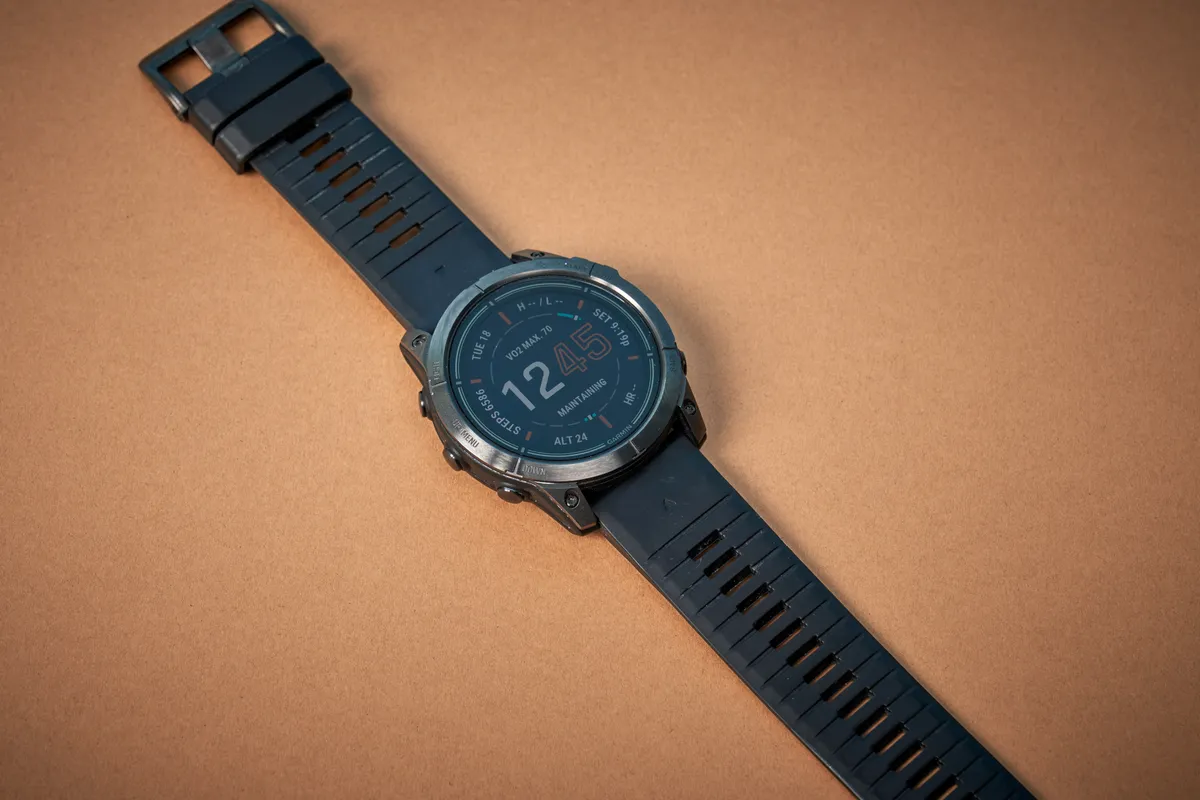
- £929.99 / $999.99 / €1,049 / AU$1,699 as tested
- Easy-to-read display and maps
- Huge battery life; useful flashlight
The Garmin Epix Pro lives up to its status as the brand's range-topping multisport watch, but your bank balance will know about it.
Despite not having solar charging, the battery life can last weeks even if you record daily activities.
You'll have no problems reading the Epix Pro's brilliantly clear AMOLED display on or off the bike. It also has a flawless touchscreen, highly detailed maps and loads of smart tech including a powerful flashlight with adjustable brightness.
With a multitude of fitness and health metrics, and sport modes, the Epix Pro tracks and records more than most people will wish for. Don't put too much faith in its wrist-based heart rate monitor though.
Garmin Fenix 7 Sapphire Solar
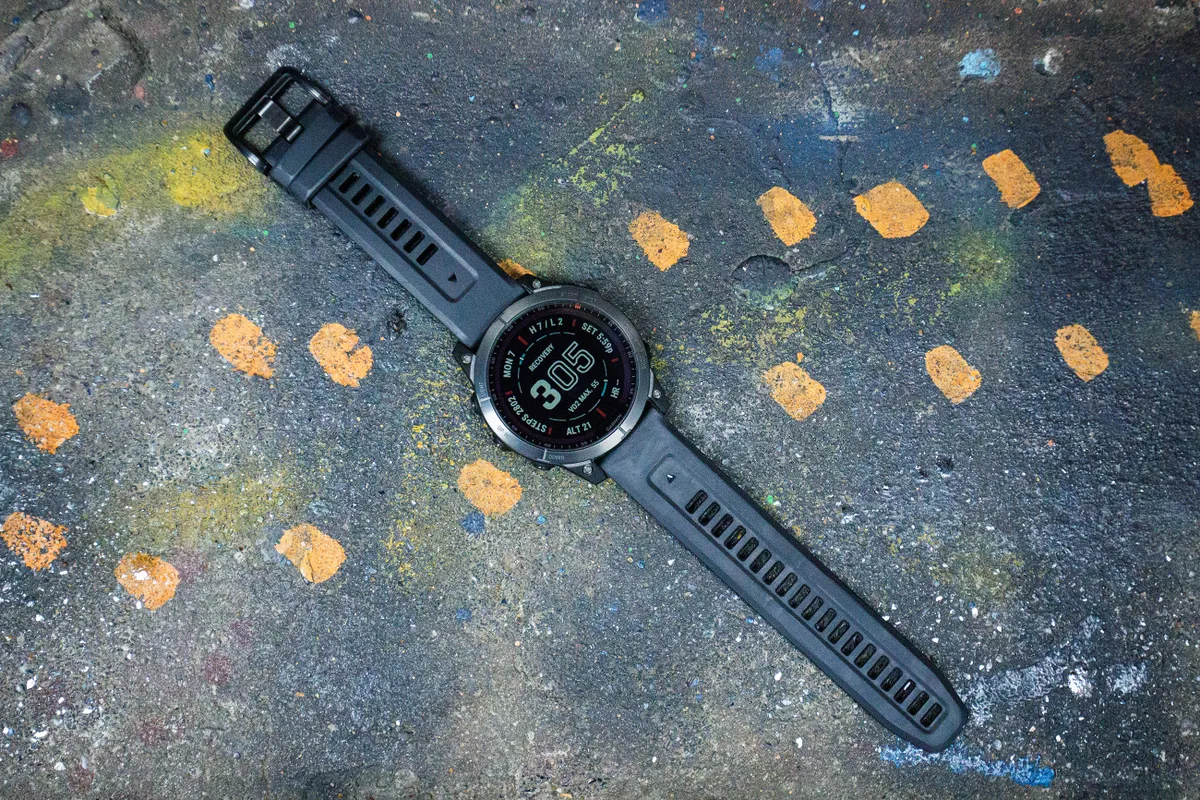
- £779.99 / $899.99 / €899.99 as tested
- New touchscreen and improved battery life
- Pricey
The Fenix 7 is Garmin's flagship solar-enhanced GPS multisport smartwatch, replacing the Fenix 6 when it was launched in January 2022.
The Fenix 7 has all the features you can expect from a Garmin smartwatch and it also has several upgrades over its predecessor, including a touchscreen and enhanced battery life.
The touchscreen brings the watch more in line with the functionality of Garmin’s bike computers, and other smart devices generally. Using the customisable maps is particularly easy with the touchscreen.
The battery life is monumental and the solar charging keeps the watch powered up for long stretches of time.
This is also the first time you can get the Fenix with solar charging and reinforced glass.
The watch comes packed with training functions, but to make the most of these for cycling you will need a power meter.
It does have an in-built heart rate monitor, but this isn’t as accurate as a chest-strap monitor.
Polar Ignite GPS fitness smartwatch
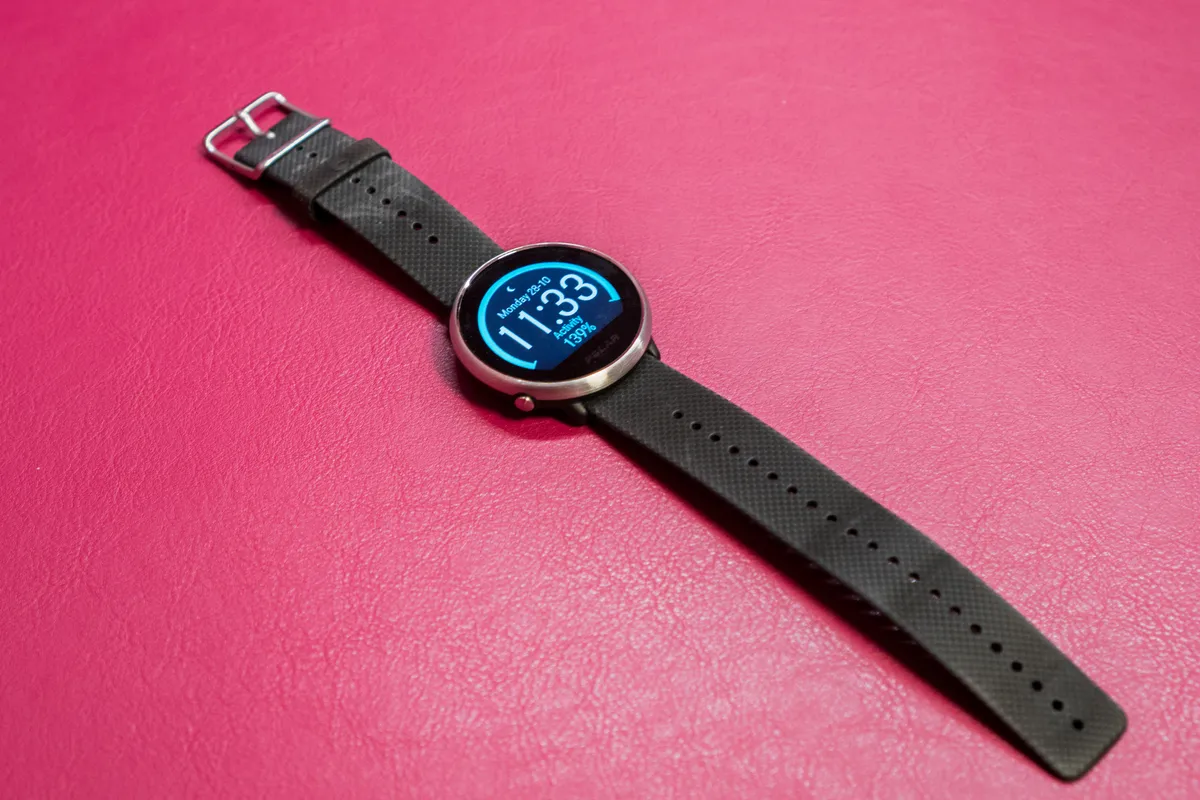
- £174.50 / $229.95 / AU$349 / €199.95 as tested
- Great battery life and data
- Heart rate monitor isn’t the best
The Polar Ignite GPS fitness smartwatch is designed for cycling, running and other outdoor activities.
The watch handles GPS duties almost as well as a dedicated GPS cycling computer, with the GPS tracking only wandering in particularly dense woods during testing.
Vigorous activity did lead to some spurious data from the heart rate monitor, but as wrist-based monitors are generally less reliable than other heart rate monitors it’s hard to mark the watch down for this.
The Polar Ignite features other metrics that, while not specific to cycling, proved to be surprisingly useful. These included sleep data and daily activity monitoring, where exercise is presented as a percentage to help inform you of when you should rest.
The watch is a good choice for more casual cyclists who don’t want to pay the price of a halo product or someone who's looking for greater insight into fitness, body stress and sleep.
Polar Vantage V2
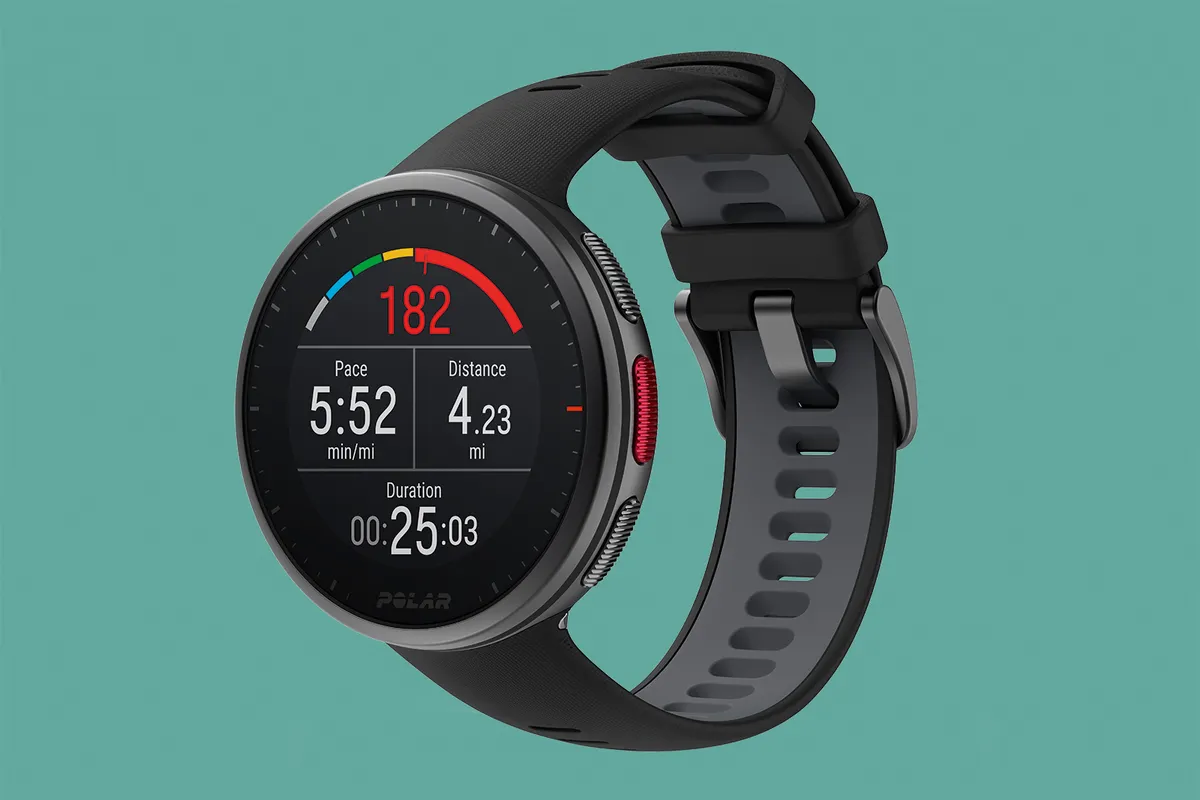
- £449 / $500 / AU$699 / €500 as tested
- Range of cycling tests
- Route visuals are limited
The Polar Vantage V2 is a multisport smartwatch with metrics for many different activities, but it has an array of cycling-specific functions and tests including Functional Threshold Power (FTP) and VO2 max.
The watch also has a function called Fuel Wise that tells you when to eat and drink. Reminders depend on ride intensity, which is established via the smartwatch’s in-built heart rate monitor.
This Polar smartwatch has navigational capabilities when paired with Komoot, but despite the bright display, the visual guidance is basic. The watch will also link up with Strava to display live segments.
The touchscreen works pretty well when wearing gloves, but there are buttons too if this proves difficult.
Battery life is impressive at 38 hours in full GPS mode (claimed battery life is 40 hours), and GPS pickup and retention are also impressive.
Also consider…
The best smartwatch for cycling will often come down to personal preference, due to the combination of particular functions. The following smartwatches scored fewer than four out of five stars in our testing, but they might just tick the right boxes for you.
Garmin Forerunner 745

- £400 / $500 / €450 / AU$849 as tested
- Variety of features including fitness analysis
- Less appealing to pure cyclists
The Garmin Forerunner 745 is a streamlined version of the Garmin Forerunner 945 and, like its more expensive sibling, it’s mightily good, just with some quibbles.
The key update to this version is its training features, which include detailed daily workout suggestions and a seven-day training load that will suggest recovery time and tell you if you are overtraining.
The Forerunner 745 smartwatch measures heart rate, and oxygen saturation of your blood via a Pulse Ox sensor. It is ANT compatible, so will connect to devices such as power meters.
Battery life is significantly lower than the Forerunner 945 and the buttons aren’t the easiest to press when wearing thick winter gloves.
The watch is primarily categorised as a running smartwatch, but does have handy features for cycling such as Garmin’s ClimbPro. Despite this, many of its features will be redundant unless you run or compete in triathlons.
If you’re a pure cyclist, you might be better off spending a bit more on the Forerunner 945 or investing in a dedicated Garmin cycling computer.
Wahoo Elemnt Rival
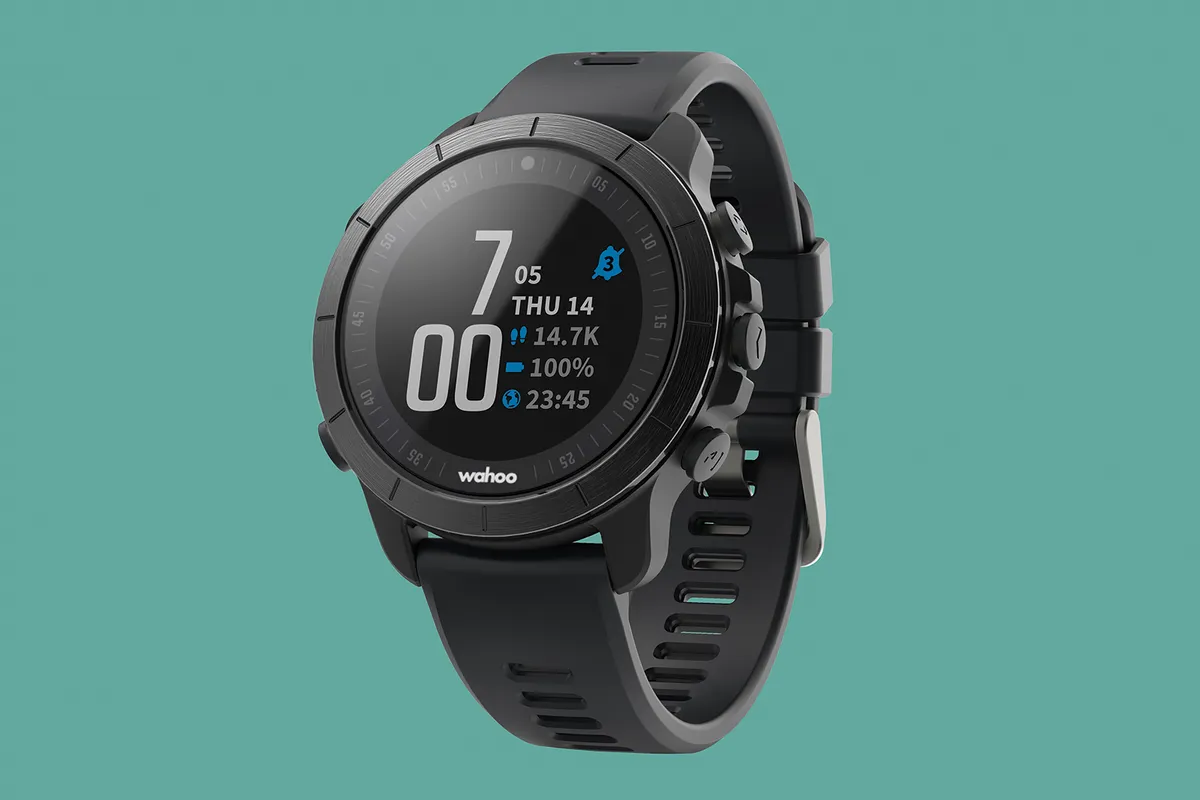
- £350 / $380 / €380 / AU$600 as tested
- Easy usability and links to Wahoo's Kickr trainer
- Lacks in-depth analysis
The Elemnt Rival is Wahoo’s first foray into the world of smartwatches.
Like with its Kickr smart trainer and Elemnt Bolt, the brand has prioritised usability for its first timepiece, stripping out features it deems unnecessary to focus on the essentials.
The Rival is easy to use but lacks in-depth performance analytics and, disappointingly, there is no navigation.
However, the Rival can be used in conjunction with the Wahoo Kickr as a form of wearable controller and its ‘touchless transition tracking’ setting automatically registers when you move into different phases of a triathlon, providing you with splits for each stage and transition.
For the pure cyclist, we'd advise spending your money on a dedicated Wahoo cycling computer instead.
Buyer’s guide to smartwatches | What to consider when buying a smartwatch for cycling
Here we run through some of the key features to look for when buying a smartwatch for cycling, as well as how smartwatches stack up against bike computers and smartphones when you’re out on two wheels.
Cycling modes
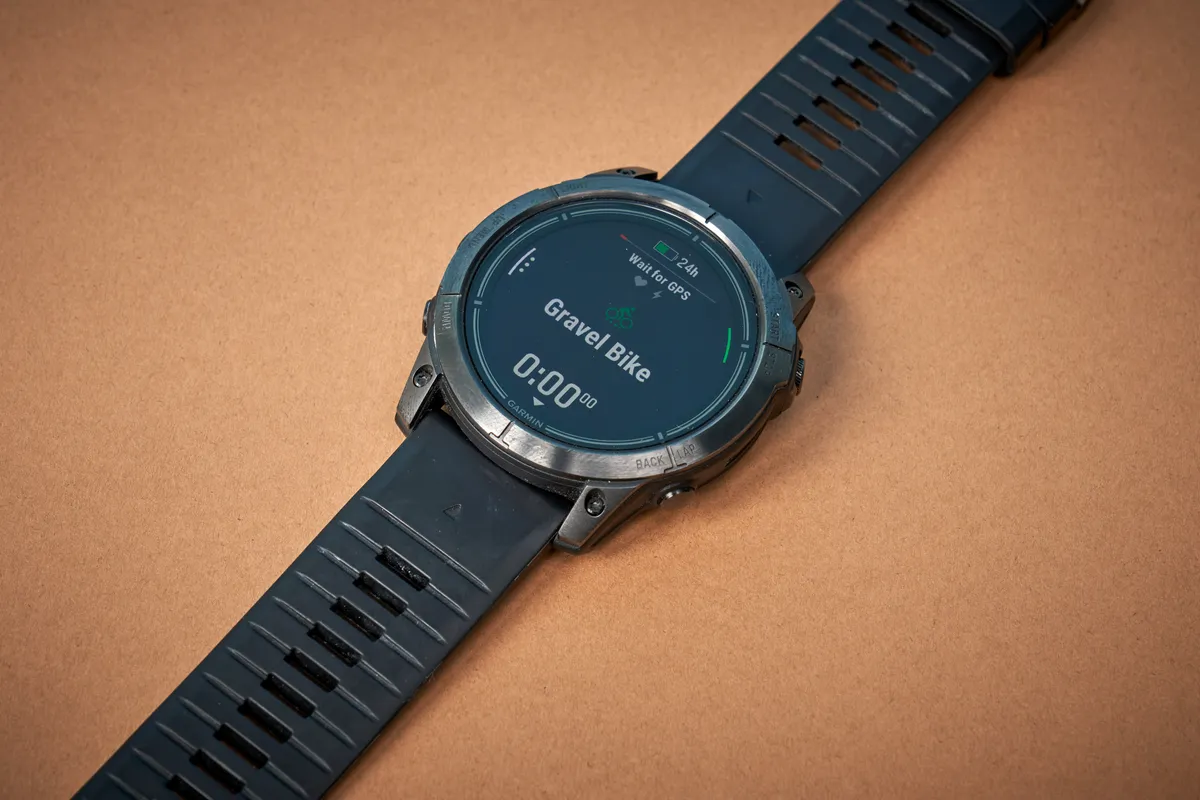
Because smartwatches tend to be designed to be used across multiple sports, they often come with different modes tailored to everything from swimming to alpine skiing. These modes will present different data fields relevant to your selected sport.
Many have specific cycling modes, with multiple profiles suited to road or mountain bike riding. Others will go as far as to provide training workouts and cycling performance tests to establish training zones.
While some provide lots of cycling-specific functions, others will be weighted more towards running for example, so it’s worth thinking about what you want from the watch and whether it has the right functionality for you.
Connectivity

If you use a heart rate strap, speed and cadence sensor, or power meter, you’re going to want a watch that will connect to them.
For the most part, it seems Bluetooth is the protocol of choice for brands these days, though some high-end watches will also include ANT connectivity.
If you connect your smartwatch to a power meter, it can display data such as power-to-weight ratio, one of the most important statistics for climbing.
However, the ubiquity of Bluetooth in GPS watches can create some difficulty if you ride with a power meter because units from SRM and Quarq only broadcast an ANT signal. Most other power meters will broadcast over Bluetooth, though.

Bluetooth connectivity also allows the watch to connect to a phone. Precisely what functionality this opens up varies from watch to watch, but most allow rides to be synced wirelessly, activity modes to be created and edited, and apps, watch faces and metrics to be downloaded if connected to your phone.
The Bluetooth connection also allows the watch to display notifications from your phone. There’s some inconsistency as to what application notifications each watch shows, but they can all be limited to just calls and texts during an activity or turned off completely.
Other smartwatches will work in tandem with a cycling computer or smart trainer. Connecting to a cycling computer is particularly useful for triathletes transitioning from the swim leg to the cycle leg and then onto the run.
Many of these watches also feature the ability to connect to your home WiFi network, so can sync your rides without a smartphone connection.
GPS watch for cycling
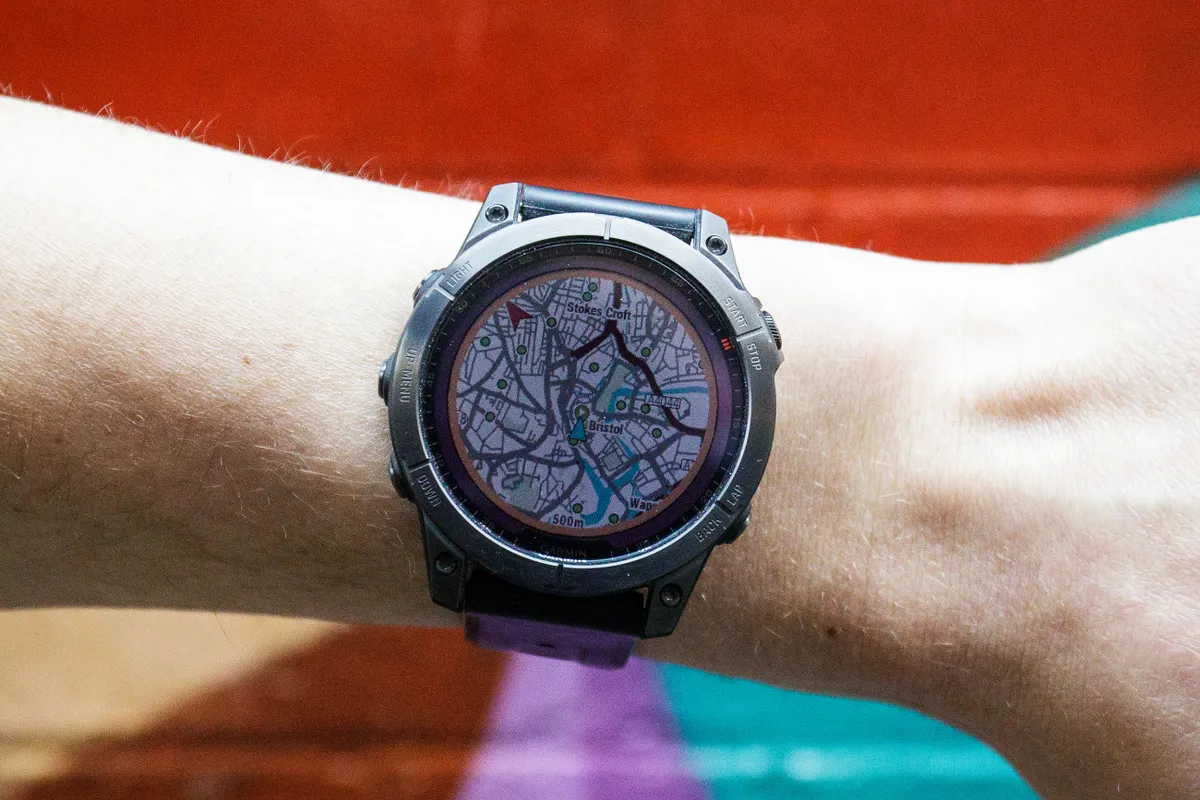
When looking for a smartwatch for cycling, it’s best to find one that has its own GPS chip because this will mean it can record rides without relying on a phone, as some lower-priced smartwatches do.
Higher-end GPS watches offer some breadcrumb-style routing, providing less detail than GPS cycling computers, although this is still enough to navigate simple terrain.
Routes must be pre-loaded into the device, but some GPS smartwatches will integrate with apps such as Komoot to provide navigation, and the watch will buzz as you approach junctions.
Wrist-based heart rate monitor
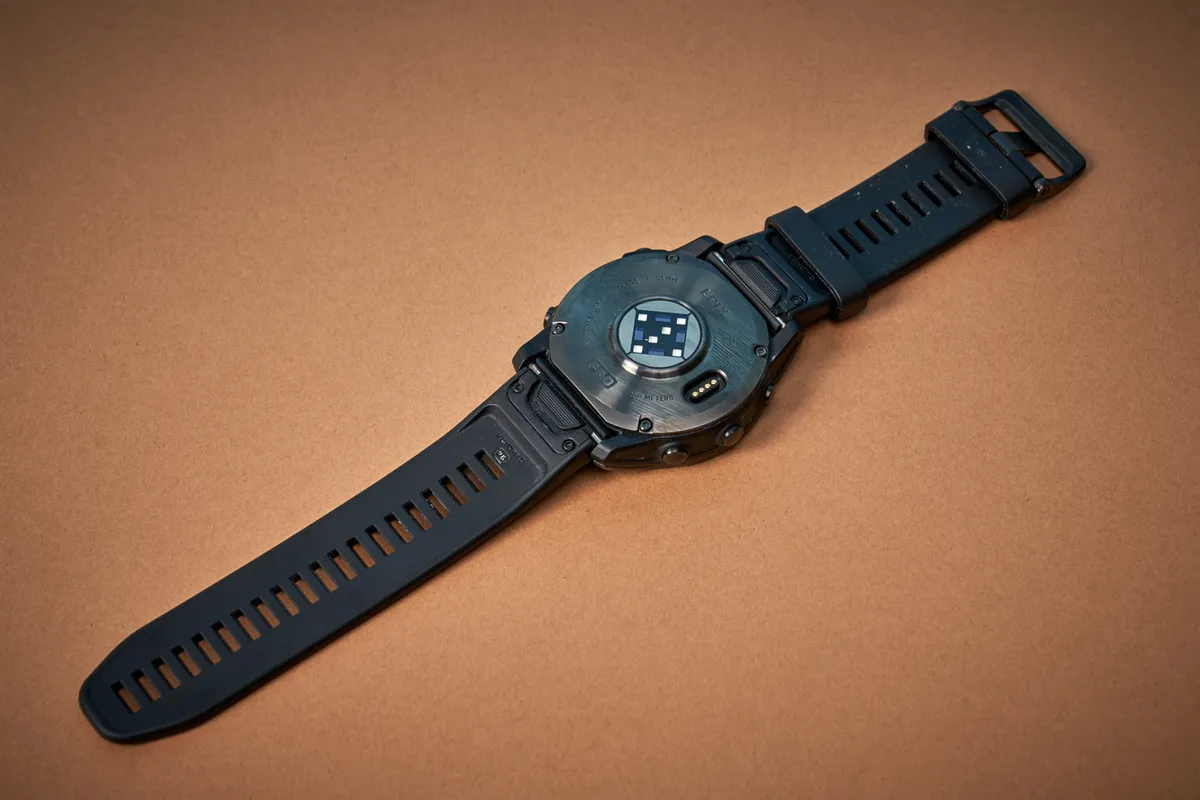
Many smartwatches come with wrist-based heart rate monitors to provide insight into how hard you’re working when training, as well as other fitness metrics, such as sleep quality and recovery.
Wrist-based heart rate monitors don’t tend to be as accurate as chest strap monitors because they use optical sensors that have to maintain contact with the skin for an accurate reading.
Having said that, many do perform well and provide good insight into heart rate and, in particular, averages rather than peaks.
Accelerometers and altimeters
Some smartwatches come with built-in accelerometers and gyroscopes, which can be helpful when GPS is turned off or there is satellite dropout. They're also useful for swimming and rep counting in gyms.
A smartwatch might also have a barometric altimeter. GPS altitude data isn’t hugely accurate, so if you want precise altitude readings, this is the way to go.
Fitness tracking and other metrics

One of the main appeals of smartwatches over bike computers or phones is that they double as fitness trackers to provide insight into your health.
Many will provide a breakdown of the quality of your sleep and others will give feedback on training intensity and tell you whether you've overtrained, as well as suggest workouts based on what exercise you've done recently.
Some will also provide information on blood oxygen levels and tell you when you have acclimatised to the altitude.
Alongside niche metrics, many smartwatches also record more basic stats such as step count and calories burned.
It is worth noting that some of this insight should be taken with a pinch of salt, but it can act as a good guide to what your body is doing.
Apps

It's common for smartwatches to support third-party apps, such as Komoot and Strava, which help with route selection and navigation as well as direct uploads to ride-sharing platforms. They can also unlock features such as Strava's live segments.
Some smartwatches also support Spotify for music streaming.
Screen size and straps

Because they have to fit on your wrist, smartwatches have smaller screens than most modern bike computers. This doesn’t stop them from being big enough to display basic routing as well as multiple data fields, though.
There can be lots of variety in screen size. For instance, the Garmin Forerunner 945's screen measures 30.4mm, while the Huawei Watch GT 2 Sport has a 46mm screen. So it’s a good idea to think about what screen size will fit on your wrist and be comfortable for you to wear.

Another consideration for comfort is strap type. Most sport smartwatches come with flexible silicone bands, but for a smarter look, some are available with metal bands, while others offer aftermarket leather and fabric bands. Some watches have a ‘tool-free’ strap change system and others require Torx or hex bolts to be removed to swap.
A scratched watch screen is no good for anybody, so most of the current GPS watch crop come with a mineral or Gorilla Glass screen, while premium units get a sapphire or crystal screen.
Smartwatch battery life

Claimed battery life is something to look into before spending your hard-earned cash on a GPS smartwatch, too.
While it’s quite common for brands to claim their watch's battery will last weeks on end, be sure to check the ‘in activity’ or GPS battery life because the internal GPS chip draws quite heavily on any battery.
Smartwatches that work like a phone

As smartwatches have grown more powerful they have begun to function more like smartphones.
While an Apple Watch probably won’t replace your cycling computer, some sports smartwatches have begun to ape Apple Watch functionality, letting you store music and pair them with headphones, as well as alert you when you receive a call and even make contactless payments.
